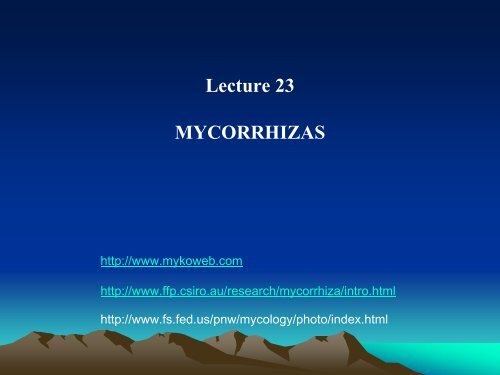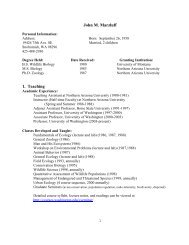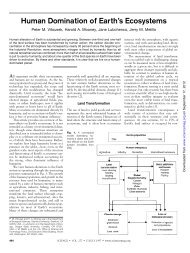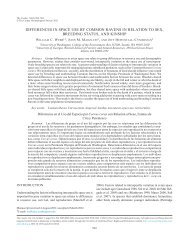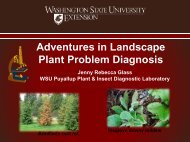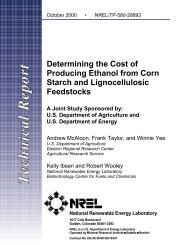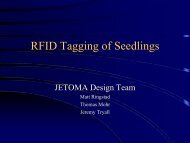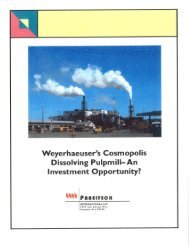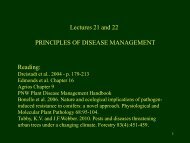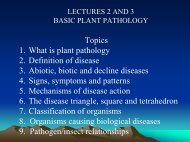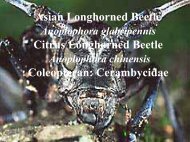Lecture 23 - Mycorrhizas
Lecture 23 - Mycorrhizas
Lecture 23 - Mycorrhizas
You also want an ePaper? Increase the reach of your titles
YUMPU automatically turns print PDFs into web optimized ePapers that Google loves.
http://www.mykoweb.com<br />
<strong>Lecture</strong> <strong>23</strong><br />
MYCORRHIZAS<br />
http://www.ffp.csiro.au/research/mycorrhiza/intro.html<br />
http://www.fs.fed.us/pnw/mycology/photo/index.html
<strong>Lecture</strong> Topics<br />
<strong>Mycorrhizas</strong><br />
1. What are mycorrhizas<br />
2. Types of mycorrhizas<br />
3. Roles of mycorrhizas<br />
a. Benefits to plants<br />
b. Other benefits to ecosystems<br />
c. Value to humans<br />
d. Protection against pathogens<br />
e. How important are they in urban ecosystems
1. What are mycorrhizas?<br />
MYCORRHIZA<br />
Greek – Root + Fungus<br />
(fine root/fungal mutualistic symbiotic<br />
association)
<strong>Mycorrhizas</strong> are old –<br />
been around 460 million years
2. Types of <strong>Mycorrhizas</strong><br />
• Ectomycorrhizas (ECM)<br />
• Endomycorrhizas – Arbuscular (AM) or<br />
vesicular arbuscular (VAM)<br />
• Ericoid<br />
• Ectendomycorrhizas<br />
• Arbutoid<br />
• Monotropoid<br />
• Orchid
Fungal Phyla<br />
• Basidiomycota – mushrooms, puffballs,etc<br />
• Ascomycota – truffles<br />
• Glomeromycota<br />
Thousands of species of ectomycorrhizal<br />
fungi (Basidiomycota and Ascomycota– few<br />
plant species) - 2000 species of fungi are<br />
mycorrhizal with Douglas-fir<br />
Few species of arbuscular fungi (AM)<br />
(Glomeromycota) – most plant species
Overall plant fungus relationship<br />
- plant provides sugars to fungus<br />
- fungus provides nutrients and water to plants and<br />
protects plants against pathogens<br />
<strong>Mycorrhizas</strong> and Plant Families<br />
Most plant families are mycorrhizal (90%)<br />
Non-mycorrhizal plants – e.g., aquatic plants, mustard family<br />
Types of mycorrhizas and plant families<br />
- Ectomycorrhizae – trees in Pineacea, Betulaceae, Fagaceae,<br />
Dipterocarpaceae, Myrtaceae (Eucalyptus)<br />
- Endomycorrhizae (arbuscular)– most plant families, including<br />
trees in the Cupressaceae<br />
- Ericaceous – Ericaceae – Erica to Vaccinium<br />
- Arbutoid – Ericacaea - Arbutus, Arctostaphylos and Pyrola<br />
- Orchid – Orchidaceae<br />
- Monotropoid - Monotropaceae<br />
- Ectendo - Pinaceae
Type AM ECM Ectendo- Arbutoid<br />
Monotropoid<br />
Ericoid Orchid<br />
Septate hyphae -(+) + - + - + + + +<br />
Hyphae in<br />
cells<br />
+ - + + + + +<br />
Hyphal coils + - - - - - + +<br />
Arbuscules + - - - - - -<br />
Mantle - + (-) + (-) + + - -<br />
Hartig net - + + + + - -<br />
Vesicles + - - - - - - -<br />
Plants<br />
Vascular<br />
plants<br />
Gymnosperms &<br />
Angiosperms<br />
Ericales<br />
Monotropaceae<br />
Ericales<br />
Chlorophyll + + + - + + -<br />
Fungi<br />
Glomero<br />
-mycota<br />
Most Basid-, but some Asco- and Zygo-<br />
Asco-<br />
(Basid-)<br />
Orchidaceae<br />
Basid-
Ectomycorrhizal Fungi<br />
Suillus sp.<br />
Basidiomycota
Belowground ectomycorrhizal<br />
fungi – spores spread by<br />
small mammals eating fruiting<br />
bodies (truffles - Ascomycota)
Hyphae (with crosswalls –septate)<br />
do not penetrate plant cell walls<br />
Two ectomycorrhizal<br />
fungi forming mantle<br />
on same fine root<br />
Mantle<br />
Hartig net<br />
Cross section of Douglas-fir fine<br />
Root showing ectomycorrhizal<br />
mantle and Hartig net
Ectomycorrhizal root<br />
Morphotypes
Hyphae (without crosswalls) penetrate<br />
cell wall, but not cell membrane<br />
ENDOMYCORRHIZAS<br />
Arbuscular mycorrhiza (AM)<br />
(Vesicular arbuscular mycorrhizas)<br />
No mantle, no Hartig net<br />
Arbuscules<br />
Large spores<br />
Vesicles<br />
Glomus
ARBUTOID MYCORRHIZA<br />
Arbutus<br />
Hyphae in cells<br />
Hartig net<br />
Mantle<br />
No Hyphal coils
Achlorophyllous plants are connected to trees via<br />
mycorrhizal fungi<br />
Monotropoid<br />
Hyphae in cells<br />
Hartig net<br />
Mantle<br />
No Hyphal coils
ERICOID MYCORRHIZA<br />
Hyphae in cells<br />
Hyphal coils<br />
No Hartig net<br />
No mantle
ORCHID MYCORRHIZA<br />
Rhizoctonia, Armillaria<br />
Hyphae in cells<br />
Hyphal coils<br />
No Hartig net<br />
No mantle
a. Benefits to plants<br />
3. ROLES OF MYCORRHIZAS<br />
Increase plant nutrient supply by increasing root<br />
surface and acquiring nutrient forms (organic)<br />
normally available.<br />
Protection from parasitic fungi and nematodes<br />
Improving water relations and phytohormones
. Other benefits to ecosystems<br />
Soil hyphae may prevent nutrient losses from the<br />
system, especially at times when roots are<br />
inactive.<br />
Hyphae are conduits that may transport carbon and<br />
nutrients from one plant species to another<br />
through mycorrhizal hyphal network. Argument<br />
for biodiversity<br />
Provide food for mammals and invertebrates
c. Values to people<br />
ECM fungi are economically and nutritionally important as<br />
human food resources. These mushrooms have also<br />
have been used as medicines and natural dyes. Fungi<br />
have aesthetic values and are an important part of the<br />
as culture, folklore and appreciation of nature by many<br />
people<br />
Fungal diversity is a bio-indicator of environmental quality.<br />
Fungi which have adapted to local soil conditions are<br />
required for agriculture, horticulture and forestry.
d. Protection against plant pathogens<br />
Phytophthora symptoms on Port Orford Cedar
Phytophthora treatment in Washington Park Arboretum
Nonectomycorrhizal<br />
pine roots<br />
Ectomycorrhizal<br />
pine roots
e. How important are mycorrhizas in urban<br />
ecosystems?<br />
• What is the mycorrhizal status of urban plants?<br />
• Do we need to inoculate urban soils/plants?<br />
• How important are they in urban ecosystem restoration?<br />
• Do invasive species influence mycorrhizas?


